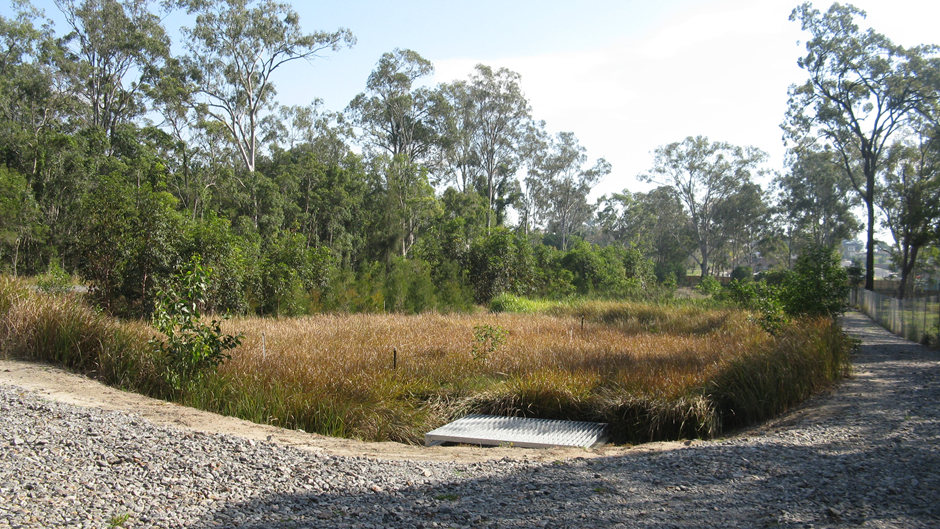|
|
Treatment systems for urban stormwater managementUrban development can generate impacts on water quality due to chemical and pollutants from roads and roofs. Hard surfaces also cause water to runoff much faster, rather than soak into the ground. Collectively, these impacts can result in what is referred to as “urban stream syndrome”, which is a term used to refer to creeks and streams that have been seriously degraded health[1]. Best management practices (BMPs) can improve stormwater quality by filtering and processing key ollutants and reduce stormwater by slowing, retaining, and infiltrating runoff. Water Sensitive Urban design (WSUD) is an integrated approach to minimise the impacts of urban stormwater. It provides a toolkit of BMPs and planning practices that can be used to control stormwater and its impacts on waterways[2]. This webpage provides summary of treatment for urban stormwater but provides links to resources which contain more detailed information. Quick facts
Water Sensitive Urban DesignWater Sensitive Urban design (WSUD) seeks to minimise the impact of urban development and maximise beneficial economic, environmental, and social outcomes for communities. This requires the careful planning, design and integration of built and natural infrastructure including drinking water, stormwater and wastewater. Treatment systems complement, but do not replace the need for measures to prevent the loss of pollutants from the source, such as erosion control (e.g. pile fields, ground cover) or remove the need to implement nutrient, sediment, chemical and water best management practices. Best management practices are the essential first step in any treatment train to prevent or minimise pollutants entering the water system. During construction works, erosion and sediment control (ESC) practices must be used to avoid the generation of stormwater. After construction works, structural BMPs must be used to reduce, reuse, and treat stormwater runoff. These BMPs may be configured in a treatment train, a combination of BMPs that form part of a connected system that provide a complimentary and staged approach to managing stormwater. Living WaterwaysThe Living Waterways Framework developed by Water by Design (Healthy Land & Water) is a best practice tool to design urban areas so they achieve WSUD outcomes. It accounts for the multiple benefits associated with avoiding, reducing and reusing stormwater runoff, including minimising impervious surfaces and using rainwater tanks and stormwater harvesting systems. It also recognises activities that protect and enhance environmental values, including restoring habitat and community stewardship. It may be used alongside current methods to achieve compliance with the State Interest for Water Quality, including modelling using the Model for Urban Stormwater Improvement Conceptualisation (MUSIC). Stormwater treatment planning requirementsThe State Planning framework through the State Planning Policy directs matters of “State Interest” that Local Governments must approximately integrate into any new or amended planning schemes for the respective area. The State interest for Water quality is one of 17 State interests and is stated as “The environmental values and quality of Queensland waters are protected and enhanced” and requires local government to incorporate appropriate policies in land zoning, development location, design, and construction, best practice erosion and sediment control during construction, post-construction stormwater management and development in water resource catchments and water supply buffer areas. Additional informationEnvironmental Protection Policy (Water) Urban stormwater quality WSUD page at Water by Design/Healthy Land and Water Water by Design: Technical design guidelines Plant selection for WSUD: WSUD design guidelines for Mackay How to prevent erosion on building sites The Queensland Government and Healthy Land and Water have a series of fact sheets available on mobile platforms for control measures to minimise soil erosion and control other pollutants from house building sites available here Life Cycle Costs of Water Sensitive Urban Design (WSUD) Treatment Systems Reef Catchments Water Sensitive Urban design References
Last updated: 27 June 2022 This page should be cited as: Department of Environment, Science and Innovation, Queensland (2022) Treatment systems for urban stormwater management, WetlandInfo website, accessed 18 March 2024. Available at: https://wetlandinfo.des.qld.gov.au/wetlands/management/treatment-systems/for-urban/ |

 — Department of Environment, Science and Innovation
— Department of Environment, Science and Innovation


